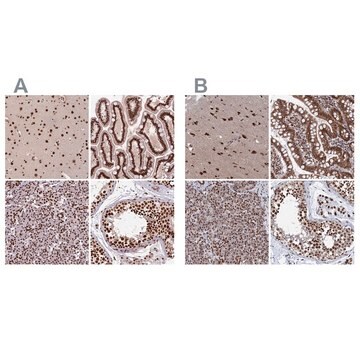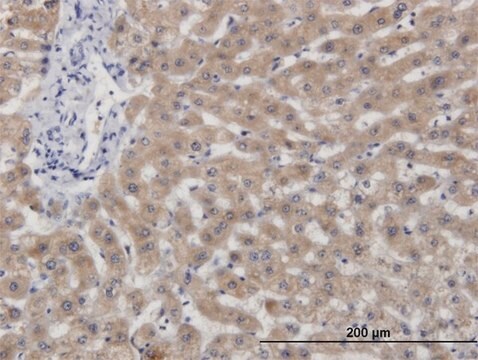SAB1402978
Monoclonal Anti-MLL2 antibody produced in mouse
clone 2E1, purified immunoglobulin, buffered aqueous solution
Sinónimos:
AAD10, ALR, CAGL114, MLL4, TNRC21, Anti-AAD10, Anti-ALL1-related protein, Anti-ALR, Anti-CAGL114, Anti-Histone-lysine N-methyltransferase, Anti-KMS, Anti-KMT2B, Anti-KMT2D, Anti-Kabuki make-up syndrome, Anti-Kabuki mental retardation syndrome, Anti-MLL4, Anti-Myeloid/lymphoid or mixed-lineage leukemia 2, Anti-TNRC21
About This Item
Productos recomendados
origen biológico
mouse
conjugado
unconjugated
forma del anticuerpo
purified immunoglobulin
tipo de anticuerpo
primary antibodies
clon
2E1, monoclonal
formulario
buffered aqueous solution
mol peso
antigen ~37.11 kDa
reactividad de especies
human
técnicas
indirect ELISA: suitable
western blot: 1-5 μg/mL
isotipo
IgG2aκ
Nº de acceso NCBI
Condiciones de envío
dry ice
temp. de almacenamiento
−20°C
modificación del objetivo postraduccional
unmodified
Información sobre el gen
human ... MLL2(8085)
¿Está buscando productos similares? Visita Guía de comparación de productos
Descripción general
Inmunógeno
Sequence
SKLEGMFPAYLQEAFFGKELLDLSRKALFAVGVGRPSFGLGTPKAKGDGGSERKELPTSQKGDDGPDIADEESRGLEGKADTPGPEDGGVKASPVPSDPE
Acciones bioquímicas o fisiológicas
Forma física
Cláusula de descargo de responsabilidad
Not finding the right product?
Try our Herramienta de selección de productos.
Código de clase de almacenamiento
10 - Combustible liquids
Clase de riesgo para el agua (WGK)
WGK 1
Punto de inflamabilidad (°F)
Not applicable
Punto de inflamabilidad (°C)
Not applicable
Certificados de análisis (COA)
Busque Certificados de análisis (COA) introduciendo el número de lote del producto. Los números de lote se encuentran en la etiqueta del producto después de las palabras «Lot» o «Batch»
¿Ya tiene este producto?
Encuentre la documentación para los productos que ha comprado recientemente en la Biblioteca de documentos.
Nuestro equipo de científicos tiene experiencia en todas las áreas de investigación: Ciencias de la vida, Ciencia de los materiales, Síntesis química, Cromatografía, Analítica y muchas otras.
Póngase en contacto con el Servicio técnico








